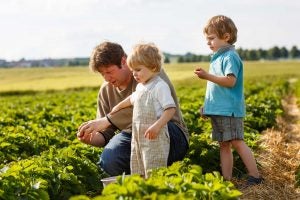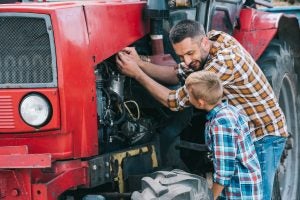“Safety third!” If your collar’s blue enough, or if you keep company with a rowdy crowd, you’ve heard this mantra — maybe even utilized it yourself. Naturally, in the real world we know we can’t always do things by the book and our risk-taking capability needs to be somewhat healthy. But when it comes to our youth, we want our margin for error to be as close to nonexistent as we can possibly make it.
Too often in agriculture, we become overly familiar in our surroundings; our workplace is usually the backyard after all. And it’s easy to overlook how some of the greatest dangers rural youth may ever face is right there at home. What is common sense to you may be a foreign language to an under-developed frontal cortex. And for every farm injury involving children, there was a family who liked to think such a horror simply wasn’t possible.
Farm accidents and hazards aren’t easy to statistically quantify. There is no national repository for youth ag-specific injuries, and it is believed that as many as 88 percent of agricultural related injuries and illnesses go undetected under the typical medical surveillance methods of data capture. According to the National Children’s Center for Rural and Agricultural Health and Safety 2022 fact sheet available on their website, cultivatesafety.org (a valuable resource, I might add), a child dies in an ag-related accident every three days — and each day, 33 might be injured. And the data does tell us that minor work-related fatalities in agriculture exceed other industries.
Other key points:
- From 2015-2017, as many as 79 percent of youth under age 18 were not working when injured on a farm.
- An estimated 738 hired and 3,735 visiting youth were injured on farms in 2014 (the most recent data available).
- Vehicles were the leading source of injury for household working youth, including ATVs.
- In 2021, the annual cost of childhood ag-related deaths was $605 million, while the annual cost of non-fatal childhood ag injuries was $1.4 billion.

Statistically more than half of youth who reside on a farm also work there in some capacity. And even to the very youngest, the farmyard is home to a host of untapped dangers around every corner.
It may seem monotonous, but I am a firm believer every farm family and employee should be familiar with all the basic risks involved around the various areas of the farm and its equipment. For example, vehicles account for a very large percentage of all ag-related injuries, especially rollovers. PTOs, crushing, heavy implements, and hydraulic systems are also common points of concern.
As you might have kids, or young employees, who are of reasonable age to operate equipment, remember there is more to teach than vehicle operation. Safety too often takes a back seat in the learning curve. Driver’s education programs are notorious for their cringey, PSA-esque films. But they do aim to not only promote traffic laws, but also the less-glamorous side and statistics of the extremely serious risks involved. Learning to operate any other piece of farm equipment should be the same. Don’t just say “here’s what not to do” — take the extra moment to explain what could happen if done incorrectly. Likewise, even simple hand tools pose a risk of critical injury when used improperly.

Besides teaching proper use of equipment and safe handling. Remember to always, always have plenty of protective gear (including eye and ear protection) available. Be a good example yourself and use that gear whenever you are doing jobs.
OSHA has some fact sheets available for free. And yes, they are really boring, and yes, no one likes technicalities. But they do a decent job of explaining specific, real dangers with very real consequences. Unfortunately, there is no fast and hard concrete evidence indicating which farm jobs and machinery are relatively safe at certain ages. But Penn State Extension has this detailed handout that goes into brain development and how it correlates with ag jobs.
Young children, even those too young to take an active role working with the family, are certainly not immune from freak accidents. There are far too many heartbreaking stores about manure pit falls, pond drownings, ladder falls, livestock incidences, and equipment crushes for every single preventative step to not be taken.
Related: 7 lessons (I wish I had) learned growing up on a farm
Very young children require 100 percent attentive supervision — not one eye while someone is in the middle of a job. Think of the farm as a hazardous workplace and treat it as such with your child as an unwary “visitor.” Accidents often happen when we mistakenly assume our children, having grown up in a certain environment, are reliable enough to avoid certain dangers. These include encounters with livestock or falls from high places. When it comes to moving machinery, the best rule of thumb is to keep young children away all together, and yes this includes those rides which are always fun and innocent until there’s a tragedy. Overkill? Arguably. But for any family, one death is far, far too many.
Raising a family on the farm is full of wonder, opportunity and fun, but it is not without its thorns. One of the best ways to promote safety for you and your family is to always put it into practice. Raise your children to have a safe attitude and they’ll carry it with them throughout their lives. Have patience in training for new jobs, identify all the dangerous areas on the farm, and understand teaching the “why” you do something is just as important as the “how.”
Jaclyn Krymowski is a graduate of The Ohio State University with a major in animal industries and minor in agriculture communications. She is an enthusiastic agvocate, professional freelance writer, and blogs at the-herdbook.com.



